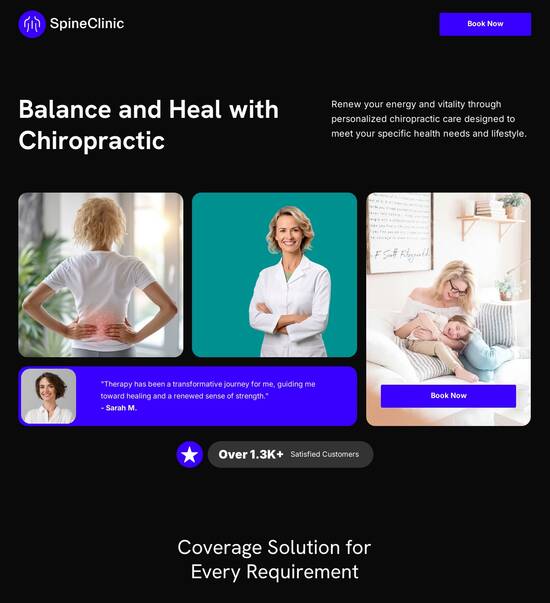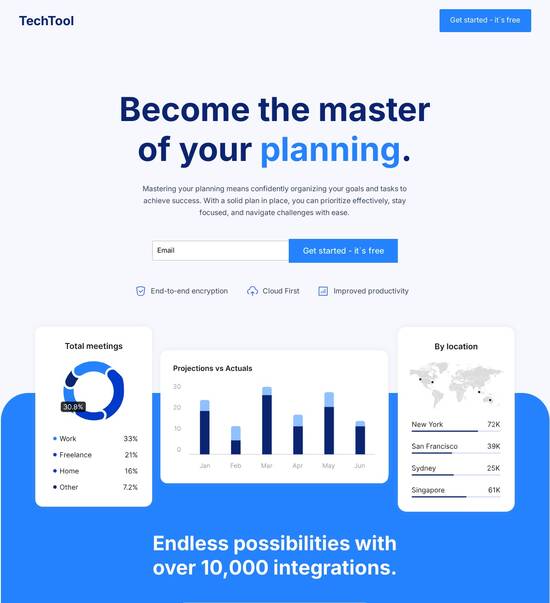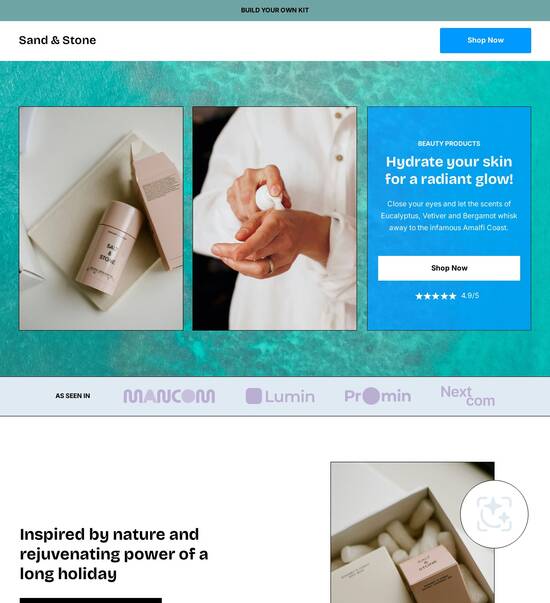
Next.js optimized disclaimer page template
Explore Similar TemplatesAbout template
Supercharge your disclaimer page with Next.js for outstanding performance! Learn more today.
Recommended templates

Easy to build without coding
With the intuitive drag-and-drop builder, anyone on your team can create high-converting pages without any knowledge of code or design. Make enhancements to your landing page with custom widgets using Javascript, HTML/CSS, or third-party scripts.

Multiple layouts for any industry and goal
Select from 500+ landing page layouts built to boost conversions across industry-specific scenarios. Customize them by adjusting fonts, adding images, and generating on-brand content with the AI assistant. Quickly scale with Instablocks® and Global Blocks that you can save, reuse, and update globally.

Loads fast and looks polished on any device
Every template is responsive, which means they present professionally on any device and load blazingly fast with our Thor Render Engine. You can also power them up with Google AMP technology to deliver an unparalleled mobile experience and drive higher conversions.

Robust analytics & experimentation
Get real-time updates and reporting across all your devices, showing the number of visitors, conversions, cost-per-visitor, and cost-per-lead. Launch AI-powered experiments, run A/B tests, and use heatmaps to analyze user behavior, then optimize your landing page to maximize conversions.







Easy to build without coding
With the intuitive drag-and-drop builder, anyone on your team can create high-converting pages without any knowledge of code or design. Make enhancements to your landing page with custom widgets using Javascript, HTML/CSS, or third-party scripts.
Multiple layouts for any industry and goal
Select from 500+ landing page layouts built to boost conversions across industry-specific scenarios. Customize them by adjusting fonts, adding images, and generating on-brand content with the AI assistant. Quickly scale with Instablocks® and Global Blocks that you can save, reuse, and update globally.
Loads fast and looks polished on any device
Every template is responsive, which means they present professionally on any device and load blazingly fast with our Thor Render Engine.
Robust analytics & experimentation
Get real-time updates and reporting across all your devices, showing the number of visitors, conversions, cost-per-visitor, and cost-per-lead. Launch AI-powered experiments, run A/B tests, and use heatmaps to analyze user behavior, then optimize your landing page to maximize conversions.
All the features you need to build lead-generating landing pages
Explore more featuresLearn how to build top-performing landing pages for any goal
FAQs
Leading the way in building high-performing landing pages





The ultimate guide to optimizing landing pages with Instapage for maximum ROI
Instapage is known for its exceptional landing page creation capabilities, making it the go-to solution for marketers aiming to enhance their digital campaigns. With its focus on conversion rate optimization (CRO), Instapage offers marketers the tools they need to design, test, and refine landing pages tailored to their target audience effectively. This guide will walk you through the essential steps of utilizing the platform while highlighting its unique value propositions.
Understanding the power of Instapage in your marketing strategy
Instapage empowers marketers to create high-converting landing pages that resonate with users. The platform's built-in experimentation features, detailed analytics, and conversion-optimized templates provide everything necessary for effective campaigns. You can access over 100 templates, which significantly reduces the time required to launch campaigns.
- High-converting templates: 100+ expertly designed templates tailored for various industries.
- Intuitive page builder: Create landing pages effortlessly without any coding skills.
- Analytics dashboard: Track performance indicators to measure campaign success.
Step 1: Choose and customize your template
The journey begins by selecting a template that best aligns with your campaign goals. Instapage offers a library of high-converting layouts ideal for various marketing objectives. Upon selecting a template, you can customize it effortlessly to reflect your brand's identity.
Step 2: Optimize for conversions
Once your template is customized, you need to focus on optimization. Use Instapage's built-in tools to create A/B tests and assess user behavior via heatmaps.
- Run A/B tests: Test different headlines or images to see which performs better.
- Utilize heatmaps: Understand where users engage the most on your landing page.
- Adjust call-to-action (CTA): Ensure that your CTAs are clearly visible and compelling.
Step 3: Personalize the user experience
Personalization is key to effective digital marketing. With Instapage, you can leverage dynamic text replacement and AdMaps to ensure that your messaging speaks directly to your audience's needs.
- Dynamic text replacement: Tailor headlines based on incoming traffic sources.
- AdMap integration: Align specific ads to landing pages for cohesive messaging.
- Audience tracking: Gather data on audience interactions to refine future campaigns.
In conclusion, Instapage is a powerful ally in your quest for optimized landing pages. By leveraging its templates, analytics, and personalization features, you can significantly enhance your campaign's ROI.
Ready to take your marketing to the next level? Start your free trial with Instapage today and unlock the potential of high-converting landing pages!
People also ask about Next.js optimized disclaimer page template
Next.js optimized disclaimer page template
Understanding Next.js: A journey into optimized disclaimer pages
Creating an effective disclaimer page is an essential part of any website, particularly for businesses that aim to protect their interests and communicate transparency to users. Next.js, a powerful framework for React, offers a marginally better approach to building these pages due to its rendering capabilities and performance benefits. This article serves as a guide to creating an optimized disclaimer page using Next.js, suited to various industries.
Defining the importance of a disclaimer page
A disclaimer page serves multiple purposes. It is a crucial legal document that protects businesses from liability related to the content provided on their websites. By effectively communicating conditions, limitations, and responsibilities, businesses can safeguard themselves against potential disputes or misunderstandings. Additionally, a disclaimer page fosters transparency with users, allowing them to make informed decisions about the information they consume.
Templates for disclaimer pages can vary significantly depending on the industry. Common components typically include clear language regarding the terms of use, liability disclaimers, and user consent for data collection. This standardization across various sectors enhances user trust, making it imperative for businesses to tailor their disclaimers to align with specific needs and regulatory requirements.
Next.js: revolutionizing web development
Next.js has emerged as a significant contender in modern web development, primarily owing to its versatility and innovative features. One of its key offerings is the ability to support server-side rendering (SSR) and static site generation (SSG), enabling faster load times and seamless navigation. It also simplifies the process of creating API routes, allowing developers to build efficient and fast APIs that can dynamically integrate with their applications.
Choosing Next.js for your disclaimer page brings substantial benefits. The framework optimizes loading speeds and enhances user experiences, essential elements for retaining user attention. Moreover, the built-in SEO capabilities of Next.js ensure that your disclaimer page is easily indexed by search engines, improving visibility and opportunity for engagement.
The essence of multipurpose SaaS themes
Multipurpose SaaS themes add significant value to web development, offering flexibility that caters to various applications across different industries. Such themes come complete with various customization options, ensuring that businesses can tailor the appearance and functionality of their sites according to specific requirements. By integrating a multipurpose theme, developers can create a cohesive design that reflects their brand while meeting particular needs.
Customizing disclaimer pages using multipurpose themes helps unify business branding. These themes readily integrate with other functionalities, such as contact forms or subscription lists, which can bolster user engagement. Hence, investing in a robust multipurpose SaaS theme not only addresses the legal requirements but also enhances the overall user experience.
Crafting effective disclaimer page templates with Next.js
When developing a disclaimer page using Next.js, several features must be kept in mind. Firstly, adopting responsive design principles is critical, ensuring that all users have access to the information regardless of the device being used. A mobile-first approach, focusing on usability for mobile devices, is essential in today's digital landscape, given the rising use of smartphones for web browsing.
Clear and concise language that communicates the purpose of the disclaimer.
Easy navigation to allow users to locate relevant sections quickly.
Visual hierarchy to enhance readability, such as headings and bullet points.
Moreover, implementing real-time localization support (RTL) adds an important dimension to your disclaimer page template. Multilingual support is increasingly essential as businesses expand their reach internationally. A well-integrated localization strategy ensures that users across various regions can understand the legal implications of the content presented to them.
Overview of available disclaimer page templates
Various Next.js templates for disclaimer pages are available, each designed to cater to different aesthetic and functional preferences. Templates vary in pricing, complexity, and customization options, allowing businesses to select a solution that best fits their needs. For instance, some templates offer drag-and-drop functionalities, while others may require basic coding knowledge to adjust.
Template 1
A minimalistic design perfect for tech-oriented businesses focused on clean aesthetics.
Template 2
An industry-specific template designed for finance sectors, emphasizing detailed legal language.
Template 3
A visually vibrant template ideal for marketing agencies that require bold messaging.
When evaluating template choices, consider factors such as performance, ease of use, and available support options. Comprehensive community reviews and developer endorsements can provide insights into the real-world effectiveness of these templates.
Navigating documentation for a seamless development process
The Next.js documentation serves as an invaluable resource for developers looking to integrate disclaimer page templates efficiently. By following best practices outlined in the documentation, developers can optimize the coding process and ensure that customization maintains optimal performance. It's advisable to harness the options available for extensive customization, ensuring that the final product aligns with both usability requirements and brand standards.
Numerous community forums and support channels exist, where developers can seek help when stuck on specific issues. Apart from forums, there are video tutorials and online courses that can guide users step-by-step through the intricate details of Next.js development. These resources enhance the learning experience and provide practical examples applicable to building disclaimer pages.
Building a custom disclaimer page: a developer's guide
Creating a custom disclaimer page begins with thorough analysis of design requirements. A developer must identify their target audience's needs, considering legal obligations that may vary by country and industry. Crafting an engaging and user-friendly interface is essential, as it will contribute significantly to user trust and satisfaction.
Step 1
Set up a Next.js environment to provide a tailored development space.
Step 2
Create individual components for headers, footers, and content areas for flexibility.
Step 3
Incorporate best development practices to ensure longevity and maintainability.
Following these steps leads to a functional and legally compliant disclaimer page that enhances user experience while addressing potential legal concerns.
Benefits of using Next.js templates for disclaimer pages
Utilizing Next.js for disclaimer pages results in significant performance improvements. Rapid load speeds enhance user experiences, as longer waiting times can lead to higher bounce rates. Furthermore, the advanced SEO capabilities inherent in Next.js allow businesses to optimize their content effectively, increasing the likelihood of being found in search results.
Additionally, incorporating accessibility features into your disclaimer page ensures that all users have equitable access to the content provided. By adhering to the Web Content Accessibility Guidelines (WCAG), businesses can cater to diverse user needs and promote inclusivity.
As web development continues to evolve, Next.js remains committed to adopting changing web standards. By leveraging Next.js templates, businesses can future-proof their web presence and adapt to new regulatory requirements as they arise.
Case studies: successful implementations
Observing real-world examples of disclaimer pages developed with Next.js sheds light on successful structures and design choices. Diverse industries illustrate how tailored approaches can enhance user experience while ensuring legal compliance. For instance, a health insurance provider implemented a comprehensive disclaimer page that effectively communicated terms while maintaining a professional aesthetic.
Feedback from users highlighted an easier understanding of the legal text, significantly reducing inquiries regarding policies. Additionally, developers who have utilized Next.js underscore its performance benefits and ease of integration, often noting it as a pivotal factor in choosing their development framework.
The future of disclaimer pages in web development
With the growing importance of legal compliance and user transparency, the role of disclaimer pages is poised to expand. Adaptive legal messaging tailored to individual users can enhance effectiveness, ensuring users feel informed rather than overwhelmed by legal jargon. As web development trends evolve, businesses must regard disclaimer pages as a vital component of user engagement strategies.
Next.js's role will be crucial in shaping the future of compliant websites. The framework's adaptability allows developers to create pages that not only serve informational purposes but also enhance overall user trust. Predictions for next-gen websites include more integrated legal solutions and frameworks that automatically update disclaimers based on changing laws or regulations.
Exploration of practical recommendations
In summary, leveraging Next.js for your disclaimer needs can significantly enhance user engagement and trust. The combination of optimized legal pages with robust development principles contributes to overall website efficiency, making it easier for individuals to understand their rights and responsibilities as users.
Businesses are encouraged to take the time to craft their disclaimer pages thoughtfully, integrating accessibility features and ensuring compatibility with evolving regulations. By doing so, they bolster brand loyalty while establishing a firm foundation of transparency and trust in user relationships.
Ready to skyrocket conversions?
Supercharge your ad campaigns with high-performing landing pages
Get started














